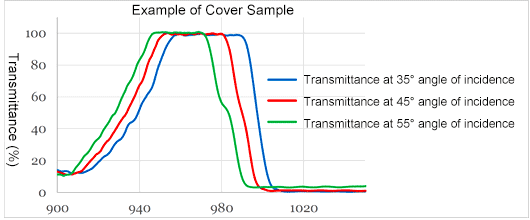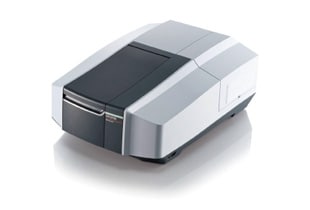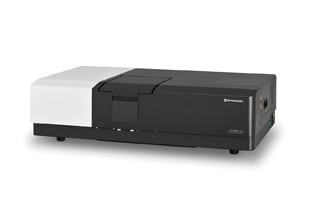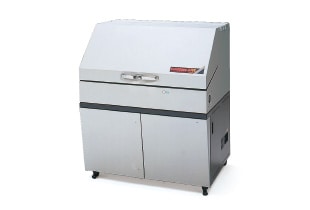Realization of a Safe Autonomous Driving Society
LiDAR Optical Properties Evaluation System
What is LiDAR?
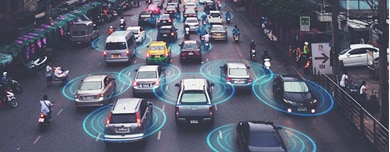
LiDAR is an abbreviation for “light detection and ranging,” in which laser light is shined onto objects, and the distance and angle to the objects are measured using the reflected light. It is important as a technology for detecting obstacles during autonomous driving, making it a key technology for achieving safe autonomous driving.
The LiDAR Optical Properties Evaluation
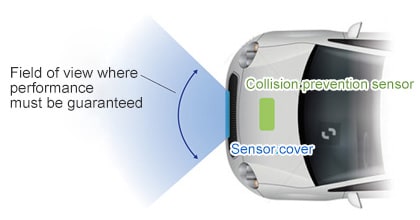
A cover for protecting sensors is installed when using LiDAR. When sensors are mounted on the front of the vehicle body, as shown in the figure on the left, the performance must be guaranteed over a wide field of view.
The wavelength band and the amount of light passing through varies depending on the angle between the laser light emitted from the LiDAR and the cover, so evaluation of the optical properties of the cover, etc. is essential in LiDAR technology.
The Shimadzu LiDAR optical properties evaluation system can measure the transmittance and reflectance from various angles using a variable angle measurement attachment. Evaluation of the angle-dependent optical properties is needed in order to achieve a safe autonomous driving society.
Evaluation of the Angle-Dependent Optical Properties of a LiDAR Cover Material
System Configuration
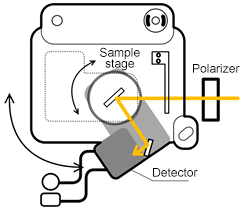
The system is configured from a variable angle measurement attachment and a spectrophotometer. The spectrophotometer can be selected according to the required wavelength range.
Variable angle measurement attachment: Enables the sample angle and the detector angle to be freely set.
Spectrophotometers for Variable Angle Measurement
| Wavelength Range | 250-1400 nm | 250-1650 nm | 250-2500 nm |
|---|---|---|---|
| Reflection Measurement | Incident angle from 5 to 70 degrees and acceptance angle from 10 to 140 degrees | ||
| Transmission Measurement | Acceptance angle 0 to 90 degrees | ||
| Title | 25 × 25 mm to 70 × 70 mm, thickness up to 15 mm | ||
Applications
At present, most LiDAR technology uses semiconductor diode lasers that emit near-infrared wavelength light at 905 nm, but technology is being developed to detect greater distances using 1550 nm wavelength lasers, which are less affected by sunlight.
The figures below show the evaluation of the angular dependence of the optical properties of a 905 nm bandpass filter and 1550 nm bandpass filter.
By measuring the transmittance when the angle of the incident light is varied between 0° and 70°, it can be seen that the central wavelength varies as the incident angle is varied.
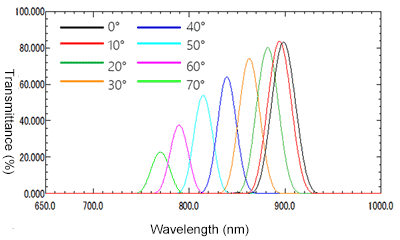
Transmission Characteristics of 905 nm Bandpass Filter
(s Polarized Light Polarizer 0°)
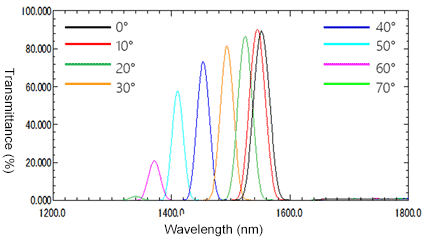
Transmission Characteristics of 1550 nm Bandpass Filter
(s Polarized Light Polarizer 0°)
Features of the LiDAR Optical Properties Evaluation
1. Very Low Stray Light Spectrophotometer
The Shimadzu UV-VIS spectrophotometers that achieve the highest level in their class for very low stray light in the ultraviolet and visible light regions (340 nm) of 0.00005 % or less, and in the near-infrared region (1420 nm) of 0.0005 % or less provide accurate measurements for safe autonomous driving.
2. Automatic Judgment Function Using the Spectral Evaluation Function
When performing quality control, the measurement results can be automatically judged to be pass or fail.
For example, if a transmittance of 90 % or higher at 980 nm is a pass, a fail is indicated in red, which can be easily seen.
